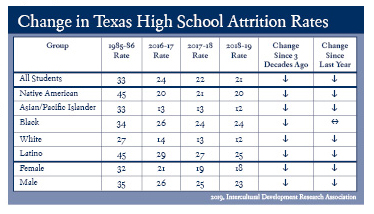• Roy L. Johnson, M.S. • IDRA Newsletter • November-December 2019 •
 The latest attrition rate data for Texas public schools shows continued gradual improvement but also persistent disparities among racial and ethnic student groups. IDRA’s latest attrition study found that 21% of the freshman class of 2015-16 left school prior to graduating in the 2018-19 school year. IDRA’s analysis of rates by race and ethnicity shows continuing disparities.
The latest attrition rate data for Texas public schools shows continued gradual improvement but also persistent disparities among racial and ethnic student groups. IDRA’s latest attrition study found that 21% of the freshman class of 2015-16 left school prior to graduating in the 2018-19 school year. IDRA’s analysis of rates by race and ethnicity shows continuing disparities.
IDRA conducted the first comprehensive study of school dropouts in Texas for the 1985-86 school year. IDRA continues to conduct these attrition analyses to assess schools’ abilities to hold on to their students until they graduate. This year’s study is the 34th in a series of annual reports on trends in dropout and attrition rates in Texas public schools. Attrition rates are an indicator of a school’s holding power, or ability to keep students enrolled in school and learning until they graduate.
Along with other dropout measures, attrition rates are useful in studying the magnitude of the dropout problem and the success of schools in keeping students in school. In simplest terms, attrition is defined as shrinkage in size or number; therefore, an attrition rate is the percent change in grade level between a base year and an end year.
Since IDRA’s landmark study in 1986, Texas schools lost more than 3.9 million students from public high school enrollment. This is the equivalent of losing the entire populations of Houston and San Antonio over the course of three decades.
The 2018-19 statewide attrition rate of 21% is 12 percentage points lower than the initial rate of 33% found in IDRA’s landmark 1985-86 study and one percentage point lower than last year. The overall high school attrition rate in Texas has ranged from 21% to 25% over the past seven years.
Across racial and ethnic groups, attrition rates are lower than they were over three decades ago when IDRA conducted the first attrition study. In the last year for each group, the attrition rate declined one or two percentage points, except for Black students whose rate stayed at 24%.

From 1986 to 2019, Texas public schools lost 3.9 million students who left without graduating with a high school diploma. As noted in IDRA’s initial attrition study, the economic impact of dropping out of school without a diploma has significant implications for students, their communities and the state. In its inaugural study, IDRA found that the dropout problem cost the State $17.12 billion per year in (a) lost wages and tax revenues, and (b) increased costs in welfare, crime and incarceration, unemployment insurance and placement, and adult training and education.
Numerous research studies and reports today document that students without a high school diploma earn significantly less over a lifetime than students with a high school diploma, and that students with a high school diploma earn significantly less than those with a college degree. One such initiative by the Alliance for Excellent Education entitled The Graduation Effect documents the connection between high school completion and the economy in the nation and all 50 states. (See http://impact.all4ed.org for costs by state or metro area.)
Key findings of the latest study include the following.
- Texas public schools fail to graduate one out of every five students.
- A total of 88,070 students from the 2015-16 freshman class were lost from public high school enrollment in 2018-19.
- Since IDRA’s landmark study in 1986, Texas schools lost more than 3.9 million students from public high school enrollment. This is the equivalent of losing the entire populations of Houston and San Antonio over the course of three decades.
- For the class of 2019, Latino students and Black students were two times more likely to leave school without graduating than White students.
- In four decades, the overall attrition rate declined from 33% in 1985-86 to 21% in 2018-19, a 36% improvement.
- Since 1986, the attrition rates of Latino students declined by 44%; the attrition rates of Black students declined by 29%; the attrition rates of White students declined by 56%; the attrition rates of Asian/Pacific Islander students declined by 64%; and the attrition rates of Native American students declined by 56%.
- The attrition gap between White students and Latino students was 18 percentage points in 1985-86 compared to 13 percentage points in 2018-19. The gap between White students and Latino students decreased by 28% from 1985-86 to 2018-19.
- The attrition gap between White students and Black students was 7 percentage points in 1985-86 compared to 12 percentage points in 2018-19. The gap between White students and Black students increased by 71% from 1985-86 to 2018-19.
- The attrition rates for males have been higher than those of females. In the class of 2018-19, males were 1.3 times more likely to leave school before graduation than females.
Further research could provide insight on the reasons for these persistent gaps and why dropout prevention initiatives are not achieving the comparable results for all racial and ethnic student groups. Secondly, impact studies could explore the effects of school policies and practices, such as discipline, zero tolerance, and in-grade retention, on disparities in attrition and dropout rates.
IDRA conducts a forecast analysis of the expected year that the attrition rate will equal zero. The latest analysis predicts that at the current pace Texas will continue to have attrition rates ranging from 21% to 25% and will not reach an attrition rate of zero until about the year 2036-37.
Clearly, there needs to be a new sense of urgency to prevent students from dropping out of school. A review of the research on effective dropout prevention strategies, including IDRA’s own research over the past four decades, shows that certain components are vital to successful dropout prevention:
- All students must be valued.
- There must be at least one educator in a student’s life who is totally committed to the success of that student.
- Families must be valued as partners with the school, all committed to ensuring that equity and excellence is present in a student’s life.
- Schools must change and innovate to match the characteristics of their students and embrace the strengths and contributions that students and their families bring.
- School staff, especially teachers, must be equipped with the tools needed to ensure their students’ success, including the use of technology, different learning styles and mentoring programs. Effective professional development can help provide these tools.
The IDRA Valued Youth Partnership program, for example, incorporates these components. It has demonstrated that successful dropout prevention is possible while at the same time nurturing student leadership (See article on Page 7).
IDRA will publish the full study online at www.idra.org in January. It will include methodology, historical statewide attrition rates and numbers of students lost to attrition categorized by race and ethnicity and by gender, a county-level data map, a county-level attrition rate table, trend data by county, and historical county-level numbers of students lost to attrition.
Roy L. Johnson, M.S., is IDRA’s director of research and evaluation. Comments and questions may be directed to him via e-mail at roy.johnson@idra.org.
 [©2019, IDRA. This article originally appeared in the November-December 2019 IDRA Newsletter by the Intercultural Development Research Association. Permission to reproduce this article is granted provided the article is reprinted in its entirety and proper credit is given to IDRA and the author.]
[©2019, IDRA. This article originally appeared in the November-December 2019 IDRA Newsletter by the Intercultural Development Research Association. Permission to reproduce this article is granted provided the article is reprinted in its entirety and proper credit is given to IDRA and the author.]


